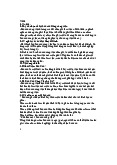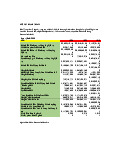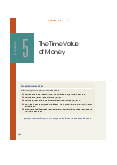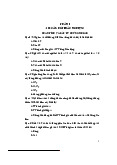







Preview text:
1.
A bond that makes no coupon payments and is initially priced at a deep discount is called a _____ bond. a. Treasury b. municipal c. floating-rate d. junk e. zero coupon 2.
Next year’s annual dividend divided by the current stock price is called the: a. yield to maturity. b. total yield. c. dividend yield. d. capital gains yield. e. earnings yield. 3.
A form of equity which receives no preferential treatment in either the payment of dividends or in
bankruptcy distributions is called _____ stock. a. dual class b. cumulative c. deferred d. preferred e. common 4. One basis point is equal to: a. .01%. b. .10%. c. 1.0%. d. 10%. e. 100%. 5.
The Robert Phillips Co. currently pays no dividend. The company is anticipating dividends of $0, $0,
$0, $.10, $.20, and $.30 over the next 6 years, respectively. After that, the company anticipates
increasing the dividend by 4% annually. The first step in computing the value of this stock
today, is to compute the value of the stock when it reaches constant growth in year: a. 3 b. 4 c. 5 d. 6 e. 7 6.
The discount rate in equity valuation is composed entirely of: a.
the dividends paid and the capital gains yield. b.
the dividend yield and the growth rate. c.
the dividends paid and the growth rate. d.
the capital gains earned and the growth rate. e.
the capital gains earned and the dividends paid. 7.
The Lo Sun Corporation offers a 6% bond with a current market price of $875.05. The yield to
maturity is 7.34%. The face value is $1,000. Interest is paid semiannually. How many years is it until this bond matures? a. 16 years 5-1 b. 18 years c. 24 years d. 30 years e. 32 years 8.
High Noon Sun, Inc. has a 5%, semiannual coupon bond with a current market price of $988.52. The
bond has a par value of $1,000 and a yield to maturity of 5.29%. How many years is it until this bond matures? a. 4.0 years b. 4.5 years c. 6.5 years d. 8.0 years e. 9.0 years 9.
Your firm offers a 10-year, zero coupon bond. The yield to maturity is 8.8%. What is the current
market price of a $1,000 face value bond? a. $430.24 b. $473.26 c. $835.56 d. $919.12 e. $1,088.00
10. The zero coupon bonds of Markco, Inc. have a market price of $394.47, a face value of $1,000, and a
yield to maturity of 6.87%. How many years is it until this bond matures? a. 7 years b. 10 years c. 14 years d. 18 years e. 21 years 11.
Lee Hong Imports paid a $1.00 per share annual dividend last week. Dividends are expected to
increase by 5% annually. What is one share of this stock worth to you today if the appropriate discount rate is 14%? a. $7.14 b. $7.50 c. $11.11 d. $11.67 e. $12.25
12. Leslie’s Unique Clothing Stores offers a common stock that pays an annual dividend of $2.00 a
share. The company has promised to maintain a constant dividend. How much are you willing
to pay for one share of this stock if you want to earn 12% return on your equity investments? a. $10.00 b. $13.33 c. $16.67 d. $18.88 e. $20.00
13. Shares of common stock of the Samson Co. offer an expected total return of 12%. The dividend is
increasing at a constant 8% per year. The dividend yield must be: a. -4%. 5-2 b. 4%. c. 8%. d. 12%. e. 20%.
14. Weisbro and Sons common stock sells for $21 a share and pays an annual dividend that increases by
5% annually. The market rate of return on this stock is 9%. What is the amount of the last
dividend paid by Weisbro and Sons? a. $.77 b. $.80 c. $.84 d. $.87 e. $.88
15. The Bell Weather Co. is a new firm in a rapidly growing industry. The company is planning on
increasing its annual dividend by 20% a year for the next four years and then decreasing the
growth rate to 5% per year. The company just paid its annual dividend in the amount of $1.00
per share. What is the current value of one share if the required rate of return is 9.25%? a. $35.63 b. $38.19 c. $41.05 d. $43.19 e. $45.81
16. Nu-Tek, Inc. is expecting a period of intense growth and has decided to retain more of its earnings to
help finance that growth. As a result it is going to reduce its annual dividend by 10% a year for
the next three years. After that, it will maintain a constant dividend of $.70 a share. Last month,
the company paid $1.80 per share. What is the value of this stock if the required rate of return is 13%? a. $6.79 b. $7.22 c. $8.22 d. $8.87 e. $9.01
17. Which of the following amounts is closest to what should be paid for Overland common stock?
Overland has just paid a dividend of $2.25. These dividends are expected to grow at a rate of
5% in the foreseeable future. The required rate of return is 11%. a. $20.45 b. $21.48 c. $37.50 d. $39.38 e. $47.70
18. Mortgage Instruments Inc. is expected to pay dividends of $1.03 next year. The company just paid
dividends of $1. This growth rate is expected to continue. How much should be paid for
Mortgage Instruments stock just after the dividend if the appropriate discount rate is 5%. a. $20.00 b. $21.50 c. $34.75 d. $50.00 5-3 e. $51.50
19. Doctors-On-Call, a newly formed medical group, just paid a dividend of $.50. The company’s
dividend is expected to grow at a 20% rate for the next 5 years and at a 3% rate thereafter. What
is the value of the stock if the appropriate discount rate is 12%? a. $8.08 b. $11.17 c. $14.22 d. $17.32 e. $30.90
20. Which of the following values is closest to the amount that should be paid for a stock that will pay a
dividend of $10 in one year and $11 in two years? The stock will be sold in 2 years for an
estimated price of $120. The appropriate discount rate is 9%. a. $114.60 b. $119.43 c. $124.20 d. $129.50 e. $138.75
21. Which one of the following statements is correct concerning the payback period? a.
An investment is acceptable if its calculated payback period is less than some pre-specified period of time. b.
An investment should be accepted if the payback is positive and rejected if it is negative. c.
An investment should be rejected if the payback is positive and accepted if it is negative. d.
An investment is acceptable if its calculated payback period is greater than some pre-specified period of time. e.
An investment should be accepted any time the payback period is less than the discounted
payback period, given a positive discount rate.
22. A situation in which accepting one investment prevents the acceptance of another investment is called the: a. net present value profile. b.
operational ambiguity decision. c.
mutually exclusive investment decision. d. issues of scale problem. e.
multiple choices of operations decision.
23. An investment is acceptable if the profitability index (PI) of the investment is: a. greater than one. b. less than one. c.
greater than the internal rate of return (IRR). d.
less than the net present value (NPV). e.
greater than a pre-specified rate of return.
24. The discounted payback rule may cause: a.
some positive net present value projects to be rejected. b.
the most liquid projects to be rejected in favor of less liquid projects. c.
projects to be incorrectly accepted due to ignoring the time value of money. d.
some projects with negative net present values to be accepted. e. Both A and D. 5-4
25. Which one of the following is the best example of two mutually exclusive projects? a.
planning to build a warehouse and a retail outlet side by side b.
buying sufficient equipment to manufacture both desks and chairs simultaneously c.
using an empty warehouse for storage or renting it entirely out to another firm d.
using the company sales force to promote sales of both shoes and socks e.
buying both inventory and fixed assets using funds from the same bond issue
26. The payback period rule accepts all investment projects in which the payback period for the cash flows is: a. equal to the cutoff point. b.
greater than the cutoff point. c. less than the cutoff point. d. positive. e. None of the above.
27. The average accounting return is determined by: a.
dividing the yearly cash flows by the investment. b.
dividing the average cash flows by the investment. c.
dividing the average net income by the average investment. d.
dividing the average net income by the initial investment. e.
dividing the net income by the cash flow.
28. What is the net present value of a project with the following cash flows and a required return of 12%? Y ear Cash Flow 0 -$28,900 1 $12,450 2 $19,630 3 $ 2,750 a. -$287.22 b. -$177.62 c. $177.62 d. $204.36 e. $287.22
29. You are considering two mutually exclusive projects with the following cash flows. Will your choice
between the two projects differ if the required rate of return is 8% rather than 11% ? If so, what should you do? Year Project A Project B 0 -$240,000 -$198,000 1 $ 0 $110,800 2 $ 0 $ 82,500 3 $325,000 $ 45,000 a.
yes; Select A at 8% and B at 11%. b.
yes; Select B at 8% and A at 11%. c.
yes; Select A at 8% and select neither at 11%. d.
no; Regardless of the required rate, project A always has the higher NPV. e.
no; Regardless of the required rate, project B always has the higher NPV. 5-5
30. What is the internal rate of return on an investment with the following cash flows? Year Cash Flow 0 -$123,400 1 $ 36,200 2 $ 54,800 3 $ 48,100 a. 5.93% b. 5.96% c. 6.04% d. 6.09% e. 6.13%
31. It will cost $2,600 to acquire a small ice cream cart. Cart sales are expected to be $1,400 a year for
three years. After the three years, the cart is expected to be worthless as that is the expected
remaining life of the cooling system. What is the payback period of the ice cream cart? a. .86 years b. 1.46 years c. 1.86 years d. 2.46 years e. 2.86 years
32. A project has an initial cost of $1,900. The cash inflows are $0, $500, $900, and $700 over the next
four years, respectively. What is the payback period? a. 2.71 years b. 2.98 years c. 3.11 years d. 3.71 years e. never
33. Yancy is considering a project which will produce cash inflows of $900 a year for 4 years. The
project has a 9% required rate of return and an initial cost of $2,800. What is the discounted payback period? a. 3.11 years b. 3.18 years c. 3.82 years d. 4.18 years e. never
34. Ginny Trueblood is considering an investment which will cost her $120,000. The investment
produces no cash flows for the first year. In the second year the cash inflow is $35,000. This
inflow will increase to $55,000 and then $75,000 for the following two years before ceasing
permanently. Ginny requires a 10% rate of return and has a required discounted payback period
of three years. Ginny should _____ this project because the discounted payback period is _____. a. accept; 2.03 years b. accept; 2.97 years c. accept; 3.97 years d. reject; 3.03 years e. reject; 3.97 years 5-6
35. You are analyzing the following two mutually exclusive projects and have developed the following
information. What is the incremental IRR? Project A Project B Year Cash Flow Cash Flow 0 -$84,500 -$76,900 1 $29,000 $25,000 2 $40,000 $35,000 3 $27,000 $26,000 a. 11.11% b. 13.01% c. 14.91% d. 16.75% e. 17.90%
36. Based on the net present value of _____for this project, you should _____ the project. a. -$2,021.28; reject b. -$406.19; reject c. $7,978.72; accept d. $9,836.74; accept e. $12,684.23; accept
37. Based on the payback period of _____for this project, you should _____ the project. a. 1.87 years; accept b. 2.87 years; accept c. 2.87 years; reject d. 3.13 years; reject e. 3.87 years; reject
The following information should be used for problems #38 - 39:
You are considering the following two mutually exclusive projects. Both projects will be
depreciated using straight-line depreciation to a zero book value over the life of the project.
Neither project has any salvage value. Project A Project B Y ear Cash Flow Y ear Cash Flow 0 -$75,000 0 -$70,000 1 $19,000 1 $10,000 2 $48,000 2 $16,000 3 $12,000 3 $72,000 Required rate of return 10 % 13 % Required payback period 2.0 years 2.0 years Required accounting return 8 % 11 %
38. Based upon the internal rate of return (IRR) and the information provided in the problem, you should: a.
accept both project A and project B. b.
reject both project A and project B. c.
accept project A and reject project B. 5-7 d.
accept project B and reject project A. e.
ignore the IRR rule and use another method of analysis.
39. Based upon the average accounting return (AAR) and the information provided in the problem, you: a.
should accept both project A and project B. b.
should accept project A because the AAR exceeds the required rate. c.
should accept project A because the AAR is less than the required rate. d.
should accept whichever project you prefer as they are equivalent from an AAR perspective. e.
cannot compute the AAR of either project.
40. An investment cost $10,000 with expected cash flows of $3,000 for 5 years. The discount rate is
15.2382%. The NPV is ___ and the IRR is ___ for the project. a. $0; 15.2382% b. $3.33; 27.2242% c. $5,000; 0% d.
Can not answer without one or the other value as input. e. None of the above. 5-8




